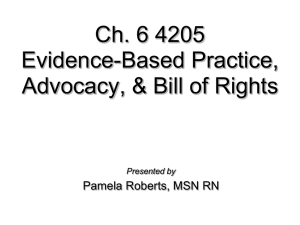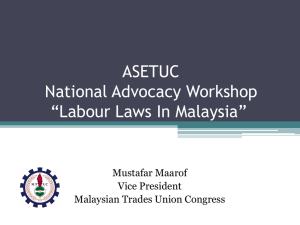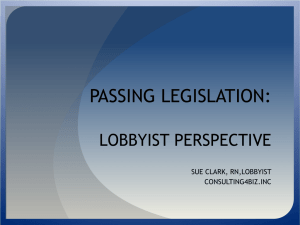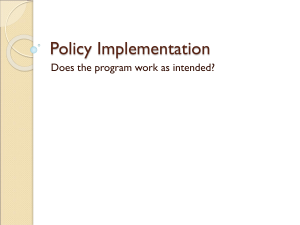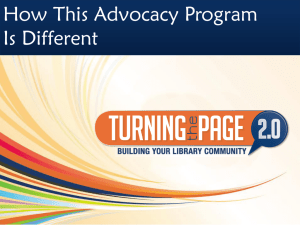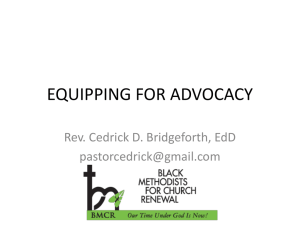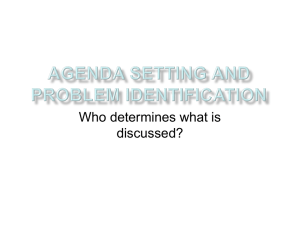Use of EBP for Advocacy: patients, units and nurses
advertisement
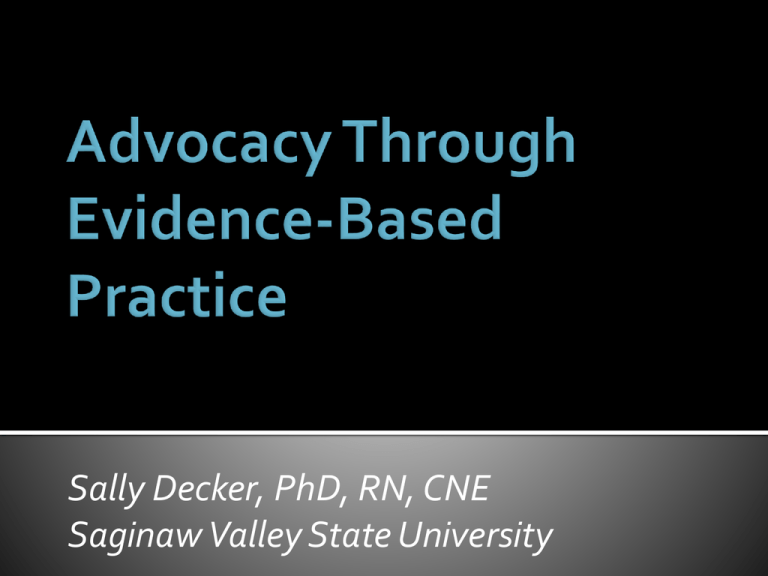
Sally Decker, PhD, RN, CNE Saginaw Valley State University Explain Evidence-Based Practice as a form of patient advocacy Explore how Evidence-Based practice can be used to advocate for the nursing profession Thinking of evidence broadly, nurses are “summoned” to use the best evidence in the care of the individual and the care of groups of individuals and the care of the nursing profession. Guardian of Patients’ rights (legal) Preservation of Patient values Champion of social justice in the provision of health care (social advocacy – use of best practice for groups) Conservator of Patients’ best interests (respect for persons- use of best practice for individuals) EBP is "the conscientious, explicit and judicious use of current best evidence in making decisions about the care of the individual patient. It means integrating individual clinical expertise with the best available external clinical evidence from systematic research." (Sackett D, 1996) EBP is the integration of clinical expertise, patient values, and the best research evidence into the decision making process for patient care. Clinical expertise refers to the clinician's cumulated experience, education and clinical skills. The patient brings to the encounter his or her own personal and unique concerns, expectations, and values. The best evidence is usually found in clinically relevant research that has been conducted using sound methodology. (Sackett D, 2002) definitions of EBP suggest practice based on the best available evidence that also incorporates patient values and preferences and clinician judgment and expertise Sackett, et al. (2000); Cronenwett et al. (2009) Advocacy has been thought of as protecting legal and moral “rights” of individuals but individuals also have the “right” to the best possible care and advocacy can be for groups and not just individuals. Evidence is generated from groups and therefore the use in a specific case can’t be assumed. Saitz (2010) writing in the Annals of Internal Medicine, questioned if the candidate performance measures for screening for unhealthy substance use in hospitals was advocacy or evidence-based practice – suggesting they were two different things. So evidence collected in one setting and for one purpose may not be the evidence needed in another setting and for another purpose Develop the question: P= population I = intervention C=comparison O=outcome t = time (Fineout-Overholt, et al.) Search for best evidence Critically analyze and synthesize Develop recommendations Evaluate the outcome of EBP changes RCTs create the highest evidence in terms of generalizability and reproducability – but are not the only evidence for use in clinical practice Polit and Beck 2008 Agency for Healthcare Research and Quality www.ahrq.gov/clinic/epcix.htm Cochrane Library www.cochrane.org Joanna Briggs Institute for Evidence-Based Nursing and Midwifery www.joannabriggs.edu.au National Guideline Clearinghouse www.guidelines.gov CINAHL/Medline Use of social statistics in the care of individuals and group – policy change Kendall-Gallagher, Aiken, Sloane, & Cimiotti (2011). Nurse specialty certification, inpatient mortality and failure to rescue. Mchugh et al. (2011). Impact of nurse staffing on safety-net hospitals. Flynn, Liang, Dickson, & Aiken (2010) Effects of nursing practice environments on quality outcomes in nursing homes. AHRQ. Hospital Nurse Staffing and Quality of Care Tapping the potential for research-based advocacy King (2011) – Policy-relevant research and evidence-informed policy in public health and now policy-directed advocacy –especially in obesity, environmental factors, food labeling. Global issues such as tobacco use have been addressed by WHO with expert synthesis of research Mmatli (2009). Translating disability-related research into evidence-based advocacy Anderson (2011). Behavioral Vaartio, Leino-Kilpi, Suominen & Puukka (2009). research in pediatric diabetes: Putting the evidence to work for advocacy and education Nursing advocacy in procedural pain care Rosenberg & Allard (2008) Women and statin use: A women’s health advocacy perspective. Ford-Gilboe, Wuest, Varcoe & Mettirr-Gray (2006). Developing an evidence-based health advocacy intervention for women who have left an abusive partner.

